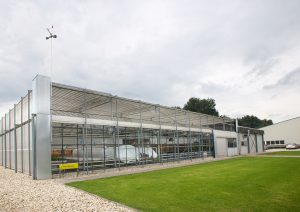
Rosellinia necatrix
White root rot caused by Rosellinia necatrix afflicts everything from apples to avocadoes. By Anna Mouton.
Rosellinia necatrix is a soil-borne fungus that attacks the roots of more than 350 plant species, notably pome- and stone-fruit, grapevines, avocadoes, citrus, and — perhaps worst of all — coffee. This article focuses on white root rot caused by Rosellinia necatrix, but it is not the only disease-causing species in the genus Rosellinia.
Economic losses due to Rosellinia necatrix have been reported from around the world. Affected crops include apples in Italy, India, and Japan; avocadoes in Italy and Spain; and grapevines in Japan. Many herbaceous plants are also susceptible. Israeli researchers even found that Rosellinia necatrix can infect and kill weeds, including slender amaranthus — Amaranthus viridis — and fleabane — Conyza bonariensis.
Recent figures on the economic impact of Rosellinia necatrix are scarce, but a 1997 Australian study found white root rot to be the most serious soil-borne disease of apples in Queensland. The authors found that more than half of the orchards were affected, with estimated annual losses to the industry of approximately AUD 1 million.
In South Africa, published reports of Rosellinia necatrix in apple and pear orchards in the Western Cape go back to 1974. Rosellinia necatrix emerged in Limpopo as a threat to avocadoes in 2016 and has since been discovered in avocadoes and macadamias in other provinces.
The Plant Disease Clinic at the Department of Plant Pathology of Stellenbosch University first identified Rosellinia necatrix in apple samples in 2006 — positive samples from most apple-growing regions, including the Koue Bokkeveld, Langkloof, Free State, and Elgin-Grabouw-Vyeboom-Villiersdorp area have since increased.
A 2013 Hortgro-funded survey isolated Rosellinia necatrix from several apple orchards in the Elgin-Grabouw-Vyeboom-Villiersdorp area.
How do I recognise white root rot?
Rosellinia necatrix not only damages roots directly but also releases toxins that spread through plant vessels. Above-ground signs include reduced vigour, retarded growth, and fewer leaves. Leaves may wilt, dry, and drop. Twigs and branches may die back. Decreased fruit size has been reported in apples.
Trees can die over a few weeks or years after first showing signs or so suddenly that no above-ground signs develop. Stress often triggers death in diseased trees.
The roots of affected trees are covered with white, cotton-like fungal growth, sheets of which may extend above the ground beneath the bark on the trunk or be visible in the soil. Black or white fungal growth may form fan-shaped patterns between the bark and the wood. Infected roots eventually rot.
Rosellinia root rots are hard to distinguish from other root infections, such as Phytophthora cinnamomi. Suspected cases should therefore be confirmed by laboratory testing, which the Plant Disease Clinic offers at the Department of Plant Pathology of Stellenbosch University.
How does Rosellinia necatrix spread?
Rosellinia necatrix is an opportunistic pathogen that attacks roots when it gets the chance. The fungus lives off cellulose-rich organic matter. In one laboratory study, researchers kept it alive for eight years on an apple branch. A different study showed that Rosellinia necatrix could survive for 18 months in pear branches.
Unlike many other fungi, Rosellinia necatrix primarily spreads through its threadlike growth — called mycelium — rather than by making spores. When the mycelium finds a root, it covers the surface and enters through lenticels or wounds, or by direct penetration.
Rosellinia necatrix can tolerate a pH of 6–8 and temperatures of 5–30 °C — it thrives at temperatures of 22–25 °C.
Various studies investigating the effect of organic matter and soil moisture on Rosellinia necatrix growth and disease-causing ability have yielded contradictory results. However, there is considerable overlap in soil conditions that favour Rosellinia and those suitable for apple production.
Apple roots are exposed to Rosellinia necatrix when planted in infected soils. The source may be previous apple trees or other host plants, including weeds.
Rosellinia necatrix can be introduced to previously clean sites through infected soil or trees. Nursery trees propagated from stool-bed rootstocks or produced in infected fields pose a higher risk than trees propagated from tissue-cultured rootstocks and grown in containers.
Control of white root rot
White root rot is difficult to control because Rosellinia necatrix can survive so long and deep in the soil. The best strategy is avoidance — plant uninfected nursery trees on uninfected soils — but growers seldom have the option to establish apple orchards on virgin land.
Chemical treatment of soils in combination with biocontrol has been evaluated but is ineffective.
Rosellinia necatrix is sensitive to high temperatures and has been successfully controlled in short-term studies by soil solarisation — covering wet soil with transparent plastic and allowing the sun to heat it.
Solarisation is less effective when fungi are deep or sites are shaded, suggesting that solarisation will probably fail to control Rosellinia in the longer term. Unlike other soil-borne pathogens limited to the top 30 centimetres of the soil, Rosellinia necatrix occurs as deep as tree roots grow — 2 metres or more.
This is why management strategies that seem to work for the first 1–2 years after treatment and planting fail after 3–4 years when tree roots have grown deeper.
Malling and Malling-Merton rootstocks generally seem to be susceptible to white root rot. Recent trials in Korea compared M.9 and M.26 to six Cornell-Geneva rootstocks, of which only two — G.202 and G.214 — have been planted in South Africa. All the Cornell-Geneva rootstocks were susceptible to Rosellinia necatrix.
Hortgro is currently funding research comparing the Rosellinia tolerance of eight Geneva rootstocks to the widely-planted M.9, M.7, M.793 and MM.109 rootstocks. Prof. Adéle McLeod of the Department of Plant Pathology at Stellenbosch University leads the project.
She is also investigating whether mulch and compost applications in orchards affect Rosellinia infections.
Image: White mycelial growth typical of Rosellinia root rot.
Supplied by Sonja Coertze | Stellenbosch University Plant Disease Clinic.






